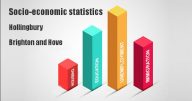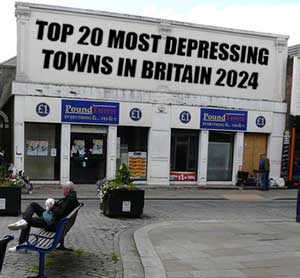We have collated a series of socio-economic statistics for Hollingbury in Brighton and Hove from UK government sources such as the 2021 Census and the Index of Multiple Deprivation. They should give you a broad snapshot of the area and the surrounding locations. Are the residents of Hollingbury older than the national average or younger? What is the population of Hollingbury and Brighton and Hove? Is Hollingbury an unemployment hotspot? This page should provide you with the answers.
Hollingbury & Brighton and Hove Immigration Statistics
We have analysed the Census 2021 raw data on country of birth and compiled immigration statistics as percentages of the population. All percentages have been rounded to two decimal places. Below are the figures for Hollingbury in the Brighton and Hove local area district.
Hollingbury has a lower rate of immigrants than Brighton and Hove, the South East region and England as a whole.
| Area |
Born in UK |
Born outside UK |
| Patcham |
89.04% |
10.96% |
| Brighton and Hove |
80.39% |
19.61% |
| South East |
84.24% |
15.76% |
| England |
82.65% |
17.35% |
Hollingbury compared to other wards in Brighton and Hove
| # |
Ward |
Born in UK |
Born outside UK |
| 1 |
Regency |
68.17% |
31.83% |
| 2 |
Brunswick and Adelaide |
71.17% |
28.83% |
| 3 |
Central Hove |
72.77% |
27.23% |
| 4 |
St. Peter's and North Laine |
73.44% |
26.56% |
| 5 |
Goldsmid |
73.64% |
26.36% |
| 6 |
Queen's Park |
74.34% |
25.66% |
| 7 |
East Brighton |
78.57% |
21.43% |
| 8 |
Westbourne |
80.02% |
19.98% |
| 9 |
Hollingdean and Stanmer |
80.8% |
19.2% |
| 10 |
Rottingdean Coastal |
81.74% |
18.26% |
| 11 |
Wish |
81.74% |
18.26% |
| 12 |
Preston Park |
81.94% |
18.06% |
| 13 |
Withdean |
82.08% |
17.92% |
| 14 |
Hove Park |
82.73% |
17.27% |
| 15 |
Hanover and Elm Grove |
83.07% |
16.93% |
| 16 |
Hangleton and Knoll |
83.52% |
16.48% |
| 17 |
Moulsecoomb and Bevendean |
83.7% |
16.3% |
| 18 |
South Portslade |
86.8% |
13.2% |
| 19 |
Patcham |
89.04% |
10.96% |
| 20 |
Woodingdean |
89.34% |
10.66% |
| 21 |
North Portslade |
90.38% |
9.62% |
';
Hollingbury is ranked 19 out of 21 wards in Brighton and Hove for the number of residents born outside of the UK.
How many residents own or rent their home in Hollingbury and Brighton and Hove
We have taken the raw data from the 2021 census and calculated what proportion of people in Hollingbury either own or rent their home. All percentages have been rounded to two decimal places. 76.48 of residents own their home either outright or mortgaged. 23.52 of Hollingbury residents rent their home either privately or through a social landlord.
| Area |
Owned |
Rented |
| Patcham |
76.48% |
23.52% |
| Brighton and Hove |
51.41% |
48.59% |
| South East |
65.66% |
34.34% |
| England |
61.31% |
38.69% |
Hollingbury has a significantly higher level of home ownership than the national average. This is indicative or an economically wealthy area.
Hollingbury compared to other wards in Brighton and Hove
| # |
Ward |
Owned |
Rented |
| 1 |
Hove Park |
79.74% |
20.26% |
| 2 |
Patcham |
76.48% |
23.52% |
| 3 |
Woodingdean |
70.69% |
29.31% |
| 4 |
Withdean |
70.34% |
29.66% |
| 5 |
Rottingdean Coastal |
67.86% |
32.14% |
| 6 |
North Portslade |
67.01% |
32.99% |
| 7 |
South Portslade |
64.04% |
35.96% |
| 8 |
Wish |
63.13% |
36.87% |
| 9 |
Hangleton and Knoll |
61.64% |
38.36% |
| 10 |
Preston Park |
58.65% |
41.35% |
| 11 |
Westbourne (Brighton and Hove) |
56.29% |
43.71% |
| 12 |
Hanover and Elm Grove |
48.17% |
51.83% |
| 13 |
Hollingdean and Stanmer |
46.58% |
53.42% |
| 14 |
Goldsmid |
46.39% |
53.61% |
| 15 |
Central Hove |
38.43% |
61.57% |
| 16 |
Moulsecoomb and Bevendean |
35.75% |
64.25% |
| 17 |
St. Peter's and North Laine |
35.03% |
64.97% |
| 18 |
Brunswick and Adelaide |
34.87% |
65.13% |
| 19 |
Queen's Park (Brighton and Hove) |
32.53% |
67.47% |
| 20 |
East Brighton |
32.31% |
67.69% |
| 21 |
Regency |
31.3% |
68.7% |
Hollingbury is ranked 2 out of 21 wards in Brighton and Hove for the percentage of home owners.
Hollingbury Unemployment Statistics
Since the introduction of Universal Credit, The Department for Work & Pensions have not issued any statistics (in our view) that can be used to ascertain the levels of unemployment or under employment in the UK, just meaningless geographic counts. However, the Office of National Statistics does publish claimant counts of people receiving out of work benefits, be that legacy Jobseeker’s Allowance or Universal Credit as a proportion of people over 16. These figures are usually updated once a month and are for Local Authority Districts and Unitary Authority Districts. So below are the figures of Brighton and Hove.
| Area |
Unemployed |
Yearly Change |
| Brighton and Hove |
4% |
-0.6% |
| South East |
2.9% |
-0.3% |
| England |
3.8% |
-0.3% |
| UK |
3.7% |
-0.3% |
The 2021 census had data on people who were economically active (seeking work) yet unemployed on Census day (Sunday March 21st 2021). These statitics do cover Hollingbury on a ward level. However, it has to be noted that the Census day was during the height of the Covid19 pandemic and therefore are not reflective of normal levels of unemployment. For example, between March 2020 and June 2020 people claiming Universal Credit doubled in most areas of the United Kingdom and then steadily declined up to the day of the Census and beyond. This data also contains the proportion of people in part-time work (working between 1-35 hours per week), which maybe an indicator of under employment in Hollingbury.
| Economic Status |
Proportion |
| In Employment |
57.67% |
| In Part-Time Work |
33.02% |
| Unemployed |
3.91% |
66.98% of the people in work, are in full-time employment in Hollingbury
Hollingbury Health Statistics
Patcham has more residents (very_good_pc-$country_health->very_good_pc, 2)%) describing their health as very good than the national average for England.
| Area |
VG |
G |
F |
B |
VB |
| Patcham |
50.44% |
33.11% |
11.72% |
3.75% |
0.98% |
| Brighton and Hove |
50.19% |
33.16% |
11.59% |
3.88% |
1.18% |
| South East |
49.98% |
34.01% |
11.77% |
3.31% |
0.93% |
| England |
48.49% |
33.71% |
12.65% |
3.98% |
1.17% |
VG = Very Good, G = Good, F = Fair, B = Bad & VB = Very Bad
How has the health of residents in Brighton and Hove changed since 2011?
Brighton and Hove residents who describe their health as either good or very good has increased by 0.45% between the 2011 and 2021 census.
| Year |
VG |
G |
F |
B |
VB |
| 2011 |
49.26% |
33.64% |
11.81% |
4.08% |
1.2% |
| 2021 |
50.19% |
33.16% |
11.59% |
3.88% |
1.18% |
VG = Very Good, G = Good, F = Fair, B = Bad & VB = Very Bad
Hollingbury Education Statistics
We have taken the raw data from the 2021 census to found of the level of education Hollingbury residents have in terms of formal qualifications as a percentage. The UK government breaks qualifications down into 7 levels. A detailed explanation of these levels can be found here. However, the Census groups these into just 4 \'levels\'. Here are some examples of the qualifications each census level represents when not stated;
- Level 1 - GCSE grades D, E, F, or G & below
- Level 2 - GCSE A*, A, B, C or O Level grades A, B or C
- Level 3 - A or AS qualification at any grade
- Level 4 - HNC, Bachelors Degree, Masters Degree or Phd
In this first table we have compared Hollingbury to the national average for England.
| Level |
Patcham |
England |
| No Qualifications |
14.91% |
18.08% |
| Level 1 |
9.33% |
9.69% |
| Level 2 |
14.35% |
13.32% |
| Apprenticeship |
4.55% |
5.32% |
| Level 3 |
17.29% |
16.92% |
| Level 4 |
37.22% |
33.92% |
Hollingbury Age Distribution Statistics
We have taken the raw data from the 2021 Census and the calculated the proportion of age groups in Patcham.
| Age Band |
Proportion |
| 4 & under |
 |
| 5 - 9 years |
 |
| 10 - 15 years |
 |
| 16 - 19 years |
 |
| 20 - 24 years |
 |
| 25 - 34 years |
 |
| 35 - 49 years |
 |
| 50 - 64 years |
 |
| 65 - 74 years |
 |
| 75 - 84 years |
 |
| 85 years & over |
 |
What are the occupations of the residents of Hollingbury?
The largest employment sector in Hollingbury is Professional Occupations. The smallest employment sector is Process Plant & Machine Operatives.
| Sector |
Proportion |
| Professional Occupations |
23.61% |
| Associate Professional & Technical |
15.12% |
| Managers, Directors & Senior Officials |
14.54% |
| Skilled Trades |
11.26% |
| Caring, leisure & Other Services |
9.05% |
| Administrative & Secretarial |
8.7% |
| Elementary Occupations |
6.89% |
| Process Plant & Machine Operatives |
4.1% |
What is the population of Hollingbury and Brighton and Hove?
The table below contains the populations figures for each ward in Brighton and Hove including Hollingbury. These population ONS figures are estimated are dated Mid 2020.
| Ward |
Population |
| Brunswick and Adelaide |
11367 |
| Central Hove |
9974 |
| East Brighton |
14145 |
| Goldsmid |
16617 |
| Hangleton and Knoll |
14798 |
| Hanover and Elm Grove |
17723 |
| Hollingdean and Stanmer |
18432 |
| Hove Park |
11058 |
| Moulsecoomb and Bevendean |
18578 |
| North Portslade |
9849 |
| Patcham |
14535 |
| Preston Park |
15215 |
| Queen's Park |
16642 |
| Regency |
12288 |
| Rottingdean Coastal |
14430 |
| South Portslade |
9790 |
| St. Peter's and North Laine |
20999 |
| Westbourne |
10364 |
| Wish |
10062 |
| Withdean |
15177 |
| Woodingdean |
9695 |
| Brighton and Hove Total |
291738 |
Last updated: 20/02/2024, Additional Sources: Office for National Statistics & Department for Work & Pensions.
How grim is your Postcode?













